Social Welfare
Enhancing Ease of Living
India’s Journey to Viksit Bharat
Posted On:
20 JUN 2025 9:15AM
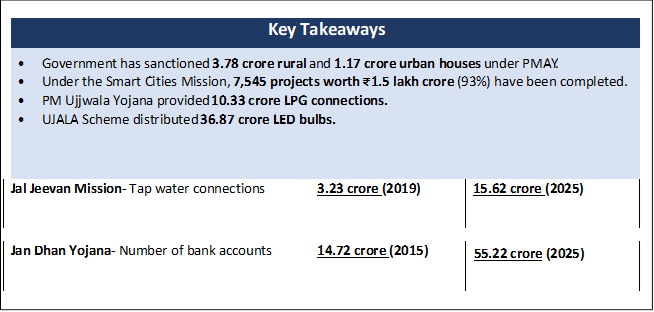
Introduction
Over the past 11 years, India has steadily strengthened the principles of good governance. The government has focused on making life easier for every citizen through efficient and fair service delivery. Citizen-centric policies and responsive administration have improved public trust and brought the system closer to the people. Special attention has been given to including and empowering the poor and underserved. As a result, ease of living has become a key indicator of how effectively the nation serves its people.
Housing and Basic Amenities
Access to quality housing and essential amenities is key to ensuring a life of dignity for every citizen. Over the past 11 years, the government has launched several flagship initiatives to provide affordable housing, electricity, clean drinking water and sanitation; especially targeting underserved and rural populations.
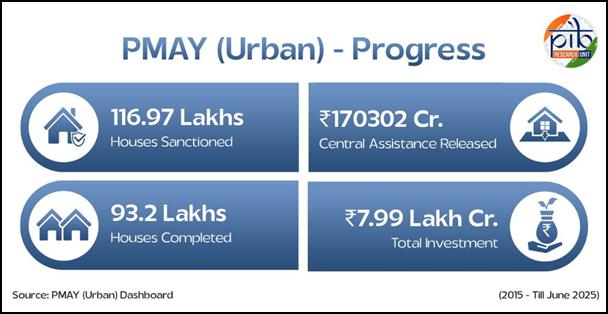
Ministry of Housing and Urban Affairs (MoHUA) is implementing Pradhan Mantri Awas Yojana – Urban (PMAY-U) since June 25, 2015 to provide pucca house with basic amenities to all eligible urban beneficiaries.
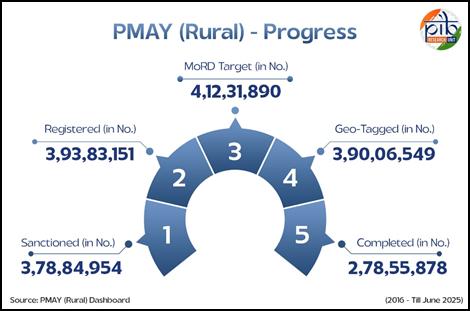
To achieve the goal of "Housing for All" in rural areas, the Pradhan Mantri Awaas Yojana–Gramin (PMAY-G) was launched on 1 April 2016. The scheme aims to provide housing with basic amenities to 4.95 crore eligible rural households by March 2029. In June 2024, the Union Cabinet approved the construction of an additional 2 crore houses under PMAY-G for the period 2024-25 to 2028-29. As of 15 June 2025, a significant number of houses have already been completed under the scheme.
- Smart Cities Mission (SCM)
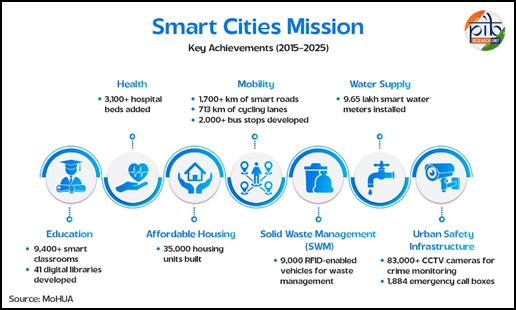
Launched on 25 June 2015, the Smart Cities Mission aims to enhance the quality of life in 100 cities through efficient services, strong infrastructure and sustainable solutions. It focuses on housing, transport, education, healthcare, and recreation.
Physical & Financial Progress: 7545 projects (93% of the total projects) worth ₹ 1,51,282 crore had been completed. The total allocated budget for the mission was ₹48,000 crore. 99.44% of total budgeted outlay (₹47,652 crore) have been released to 100 cities.
- Atal Mission for Rejuvenation & Urban Transformation (AMRUT & AMRUT 2.0)
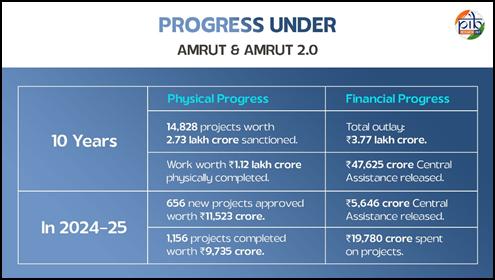
Atal Mission for Rejuvenation and Urban Transformation (AMRUT) was launched on 25 June 2015 to improve basic infrastructure in 500 cities. Its second phase, AMRUT 2.0, began on 01 October 2021 with expanded coverage across all urban local bodies. The mission focuses on making cities water secure and self-reliant by ensuring universal sewerage and septage management.
Transforming Urban India under AMRUT & AMRUT 2.0
(Key Achievements)
1. Water and Sewerage Infrastructure
In 10 Years:
- 2.03 crore tap connections and 1.5 crore sewer connections provided.
- 4,734 MLD (Million Litres per Day) Water Treatment capacity, 4,447 MLD Sewage Treatment and 1,437 MLD reuse capacity added.
In 2024–25:
- 42 lakh tap and 25 lakh sewer connections provided.
- 836 MLD WTP and 567 MLD STP capacity developed.
2. Green Spaces and Water Bodies
In 10 Years:
- 2,994 parks developed across 6,869 acres.
- 544 water bodies rejuvenated covering 9,511 acres.
In 2024–25:
- 388 parks developed (1,851 acres).
- 391 water bodies rejuvenated (7,166 acres).
3. Urban Mobility & Start-Up Innovation
In 10 Years:
- 120 Start-ups mapped with 82 cities to scale urban solutions.
- 381 'Drink from Tap' (DFT) projects worth ₹23,490 crore sanctioned to benefit 8 lakh homes.
In 2024–25:
- 15 Start-ups mapped with 46 cities.
- 29 DFT projects worth ₹1,270 crore approved.
4. Reforms and Capacity Building
In 10 Years:
- 99 lakh LED streetlights installed
In 2024–25:
- ‘AMRUT Mitra’: 1,162 projects worth ₹95 crore approved.
- ‘Jal Hi Amrit’: 860 STPs enrolled, 4,500 plant operators trained.
Universal Access to Essentials
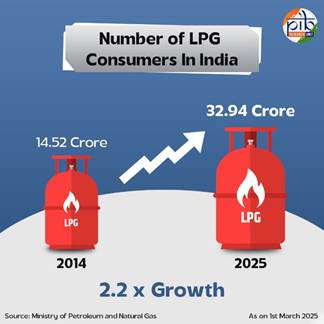
Over the past 11 years, the government has focused on ensuring universal access to basic services that are essential for a dignified life. Initiatives have aimed at reaching every household with clean water, sanitation, energy-efficient lighting and LPG connections.
Launched in May 2016, the Pradhan Mantri Ujjwala Yojana (PMUY) provides deposit-free LPG connections to adult women from poor households, promoting health and clean cooking. Ujjwala 2.0 was launched in August 2021 to cover remaining households, achieving 1.60 crore new connections by December 2022. An additional 75 lakh connections were approved for FY 2023-24 to 2025-26 and completed by July 2024. As of 1 March 2025, India has 32.94 crore active domestic LPG consumers, including 10.33 crore PMUY beneficiaries.
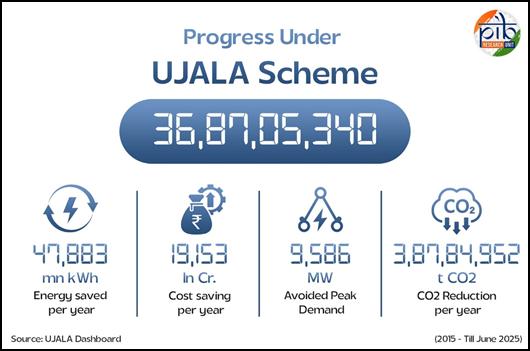
Launched on 5 January 2015, the Unnat Jyoti by Affordable LEDs for All (UJALA) scheme aims to promote energy efficiency by providing affordable LED bulbs, tube lights and fans to households. Initially introduced as the Domestic Efficient Lighting Programme, it was later rebranded as UJALA. As of 15 June, 36.87 crore LED bulbs have been distributed across the country.
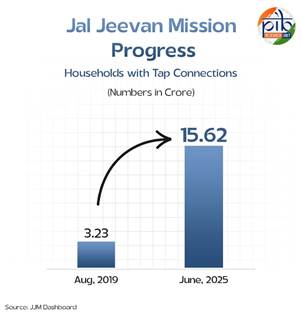
Launched on 15 August 2019, the Jal Jeevan Mission aims to provide tap water to every rural household. At launch, only 3.23 crore households had tap connections. Today, 15.62 crore rural homes are benefitting. The mission’s outlay has been increased to ₹67,000 crore and extended till 2028 to achieve 100% coverage.
- Swachh Bharat Mission (Urban & Rural)
The Swachh Bharat Mission (SBM), launched by Prime Minister Shri Narendra Modi on October 2, 2014, represents a paradigm shift towards achieving universal sanitation coverage in India.
The Swachh Bharat Mission (Urban) (SBM-U), launched on October 2, 2014, has significantly transformed urban sanitation and cleanliness in India.
SBM – Urban 1.0: The total cost of implementation of SBM – Urban based on unit and per capita costs was Rs. 62,009 Cr. The Government of India share amounts to Rs. 14,623 Cr. Out of this Rs. 11,905 Cr. has been claimed be the States/UTs.
- ii. SBM – Urban 2.0: The total cost of implementation SBM based on unit and per capita costs is Rs. 1,41,600 Cr. Out of the total mission allocation of Rs. 32,610 Cr., central share for State/UTs, a total of Rs 28,328 Cr. (86%) has been approved and Rs. 6,603 Cr has been claimed by the States/UTs.
|
Phase
|
Budget Outlay
|
|
SBM-U (2014-2021)
|
Rs. 62,009 Crore
|
|
SBM-U 2.0 (2021-2026)
|
Rs. 1,41,600 Crore
|
Swachh Bharat Mission (Grameen) aims to improve rural sanitation and end open defecation.
Phase-I (2014–2019) focused on building toilets and making villages Open Defecation Free (ODF).
- ii.Phase-II, launched on April 1, 2020, focuses on ODF sustainability and proper Solid and Liquid Waste Management (SLWM). The goal is to make all villages ODF Plus by 2025–26.
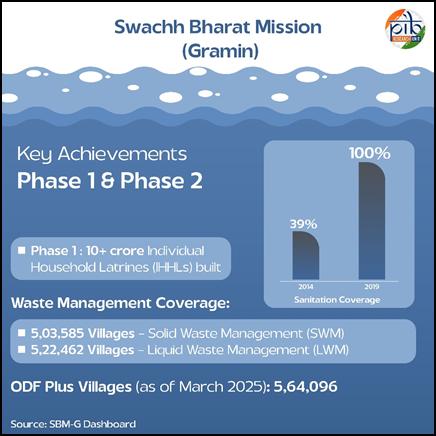
3. Financial Inclusion
In the last 11 years, financial inclusion has emerged as a powerful tool for empowering citizens and bridging socio-economic gaps. By bringing banking and digital services to the doorstep, it has enabled secure savings and greater financial independence.
Launched in August 2014, the Pradhan Mantri Jan Dhan Yojana (PMJDY) aimed to bring the unbanked into the formal financial system by expanding access to savings accounts, credit, remittance, insurance and pensions. The number of Jan Dhan accounts grew from 14.72 crore in March 2015 to 55.22 crore by June 2025.
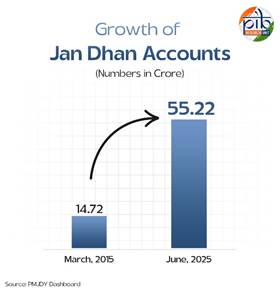
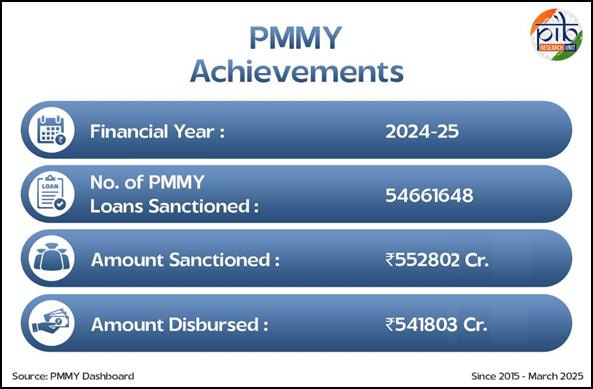
Launched on 8th April 2015, the Pradhan Mantri Mudra Yojana (PMMY) is a flagship programme of the Prime Minister aimed at providing financial support to unfunded micro enterprises and small businesses. By removing the burden of collateral and simplifying access, MUDRA laid the foundation for a new era of grassroots entrepreneurship.
4. Healthcare Access
Over the past 11 years, India has strengthened its healthcare system with a focus on accessibility, affordability, and dignity. From financial protection to targeted support for the vulnerable, the emphasis has been on making quality healthcare a right, not a privilege.
- Ayushman Bharat- Pradhan Mantri Jan Arogya Yojana (PM-JAY)
In 2018, the government launched Ayushman Bharat- Pradhan Mantri Jan Arogya Yojana (PM-JAY), the world’s largest health assurance programme, with an aim at protecting economically vulnerable Indians from catastrophic healthcare expenditures. Targeting the bottom 40% of India’s population, the scheme covers approximately 12.37 crore families; benefiting nearly 55 crore individuals.
Not just this, this scheme also targets the frontline heroes of India’s public health system, ASHA workers, Anganwadi Workers (AWWs), and Anganwadi Helpers (AWHs) ensuring their health and wellbeing as they serve the nation. AB-PMJAY is not just a health scheme, it is a social revolution in healthcare access, empowering India’s most vulnerable with dignity, care, and financial protection.

5. Transport & Connectivity
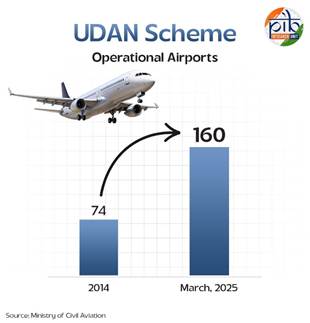
In the last 11 years, India has seen rapid expansion in highways, railways, ports, and airports. Improved connectivity has reduced travel time, enhanced logistics efficiency, and boosted regional development.
- (RCS) UDAN Scheme: Regional Connectivity Scheme (RCS) UDAN (Ude Desh Ka Aam Nagrik)
Launched under the National Civil Aviation Policy (2016), the UDAN scheme aims to make regional air travel affordable and economically viable. Operational airports in India have increased from 74 in 2014 to 160 by March 2025. The Cabinet Committee on Economic Affairs approved ₹4,500 crore for reviving unserved and under-served airports, while the Expenditure Finance Committee sanctioned ₹1,000 crore for developing 50 additional airports, heliports, and water aerodromes. Further:
- 625 routes have been operationalized;
- 88 unserved and underserved airports have been activated (including 13 heliports and 2 water aerodromes);
- Over 1.51 crore passengers have flown on RCS flights;
- 3.05 lakh flights have been operated; and
- Rs. 4,029 crore viability gap funding has been disbursed.
The scheme ensures equitable regional connectivity, with heavy focus on North East India, hilly terrain, and tribal belts. For the North East region, 90 RCS routes and 12 airports/Heliports/Water Aerodromes have been operationalised.
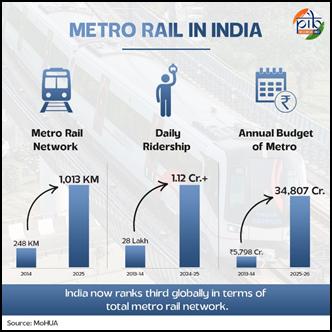
Metro rail is now either running or being built in 23 cities. By May 2025, India had 1,013 km of metro lines in operation, up from just 248 km in 2014. That is an addition of 763 km in just eleven years. India now ranks third globally in terms of total metro rail network. In this period, 34 metro projects spanning 992 km were approved.
Daily ridership, which stood at 28 lakh in 2013-14, has now crossed 1.12 crore. The pace of commissioning new lines has grown nine times. On average, 6 km of metro lines are now operationalised every month, compared to just 0.68 km per month before 2014. The annual budget for metro rail has also increased more than six times, rising from ₹5,798 crore in 2013-14 to ₹34,807 crore in 2025-26.
In addition to metro networks, India has also made significant strides with the introduction of the Regional Rapid Transit System (RRTS). The Namo Bharat trains operating on the Delhi-Meerut RRTS corridor are a prime example of India's commitment to modernising mass transit systems, offering faster and more efficient travel across regions.
Conclusion
The Government of India is committed to making life easier and more dignified for every citizen, aligning with the vision of Viksit Bharat. Through initiatives like affordable housing, universal access to water, electricity and sanitation, it is building a stronger, more inclusive nation. By focusing on responsive governance and citizen-centric policies, the government ensures that every Indian has access to opportunities and essential services, fostering a brighter, sustainable future for all.
References:
Ministry of Petroleum and Natural Gas:
Ministry of Civil Aviation:
Ministry of Power:
Ministry of Housing & Urban Affairs:
Ministry of Rural Development
Ministry of Jal Shakti
Ministry of Finance
Ministry of Labour & Employment
Click here to see in PDF
Explainer 19/ Series on 11 Years of Government
Santosh Kumar/ Sarla Meena/ Kamna Lakaria
(Backgrounder ID: 154701)
Visitor Counter : 4170
Provide suggestions / comments